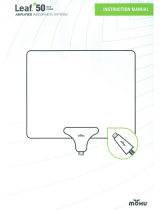I am not getting the channels the signal locator said I would!
Our site tool on www.gomohu.com looks primarily for the distance between your zip code and
the TV towers. It does not take into consideration if there are terrain issues such as hills,
mountains and/or valleys which can impede signals from reaching you nor does it identify if the
signal is being transmitted in VHF or UHF.
We would like to offer to do an in depth signal scan to see what kinds of signals are available in
your exact area and to determine if the antenna you purchased is the right one for you. If you
would please submit a ticket at
[email protected] and provide us with y
our street address
and zip code we can do a detailed analysis of the signals you can expect to receive at your
address. We can also help you trouble shoot once we determine that you are in a good area to
receive signals. We are also reachable by phone at 855-446-6648 (M-F 8am - 5pm EST).
Can I be too close to my TV towers?
An issue that can sometimes occur when you are using an amplified antenna is poor reception
when you are very close to the transmitting towers. The signal from the tower can overpower the
amplifiers on over-the-air antennas and they won't work with the amplifier on them.
To resolve, we would recommend removing the amplifier and re-scanning for channels. Other
customers with a similar situation to yours have had success with this.
Which Way Are the Signals Coming From?
While our antennas are multidirectional it helps immeasurably to have the flat face of the
antenna pointed in the direction of the towers so that the signals have as much surface to "land
on", so to speak, as possible. While the sides of our antennas will pull in signals it's a pretty
small area for signals to try and "land". Think of an antenna like a tennis racket. You COULD
use the sides of the racket to hit the ball but you'd have much more success using the webbing as
the designer had intended.
Many site tools will allow you to enter in your complete address so you can get a general idea of
which way to point your antenna. Always use your complete address so that the information is
specific to your location. Even a move of a few inches can make a huge difference with
reception.
Why can't I get channels 2 through 13?
Our antennas have a digital VHF and a digital UHF range that vary based on the style of the
antenna.











